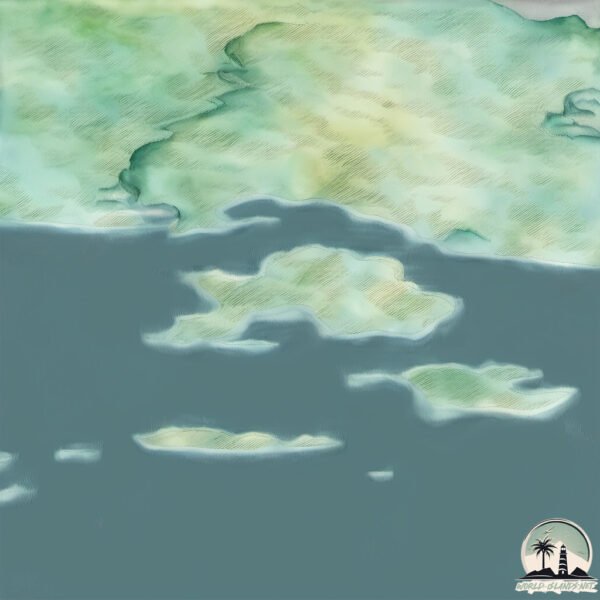Ostrov Bolshoy Tsinkovyy

Welcome to Ostrov Bolshoy Tsinkovyy, a Polar island in the Barentsz Sea, part of the majestic Arctic Ocean. This guide offers a comprehensive overview of what makes Ostrov Bolshoy Tsinkovyy unique – from its geography and climate to its population, infrastructure, and beyond. Dive into the details:
- Geography and Size: Explore the island’s size and location.
- Climate and Weather: Weather patterns and temperature.
- Topography and Nature: Uncover the natural wonders of the island.
- Infrastructure and Travelling: Insights on reaching, staying, and making the most of your visit.
- News and Headlines: Latest News.
Geography and size of Ostrov Bolshoy Tsinkovyy
Size: 4.895 km²
Coastline: 18.4 km
Ocean: Arctic Ocean
Sea: Barentsz Sea
Continent: Europe
Ostrov Bolshoy Tsinkovyy is a Small Island spanning 4.9 km² with a coastline of 18.4 km.
Archipel: –
Tectonic Plate: Eurasia – One of the world’s largest tectonic plates, the Eurasian Plate covers a significant portion of Europe and Asia. It’s characterized by diverse geological features, including the Ural Mountains, the European Plain, and the Himalayas formed from its collision with the Indian Plate.
The geographic heart of the island is pinpointed at these coordinates:
Latitude: 69.86286323 / Longitude: 59.44861617
Climate and weather of Ostrov Bolshoy Tsinkovyy
Climate Zone: Polar
Climate Details: Tundra
Temperature: Cold
Climate Characteristics: The tundra climate features long, extremely cold winters and short, cool summers. Vegetation is limited to mosses, lichens, and small shrubs due to the low temperatures and short growing seasons. Biodiversity is low, but some specialized species thrive.
Topography and nature of Ostrov Bolshoy Tsinkovyy
Timezone: UTC+04:00
Timezone places: Europe/Moscow
Max. Elevation: 18 m
Mean Elevation: 8 m
Vegetation: Herbaceous Cover
Tree Coverage: 22%
The mean elevation is 8 m. The highest elevation on the island reaches approximately 18 meters above sea level. The island is characterized by Plains: Flat, low-lying lands characterized by a maximum elevation of up to 200 meters. On islands, plains are typically coastal lowlands or central flat areas.
Dominating Vegetation: Herbaceous Cover
Comprising mainly of grasses, herbs, and ferns, these areas are common in prairies, meadows, and savannas, and can vary widely in species composition. Ostrov Bolshoy Tsinkovyy has a tree cover of 22 %.
Vegetation: 4 vegetation zones – Diverse Island
Four distinct vegetation zones mark these islands as ecologically diverse. They might feature varied landscapes such as forests, beaches, grasslands, and rocky areas. Such diversity reflects the island’s complex ecological interactions and varied habitats, which can support a rich array of wildlife and plant species.
Infrastructure and Travelling to Ostrov Bolshoy Tsinkovyy
Does the island have a public airport? no.
There is no public and scheduled airport on Ostrov Bolshoy Tsinkovyy. The nearest airport is Amderma Airport, located 230 km away.
Does the island have a major port? no.
There are no major ports on Ostrov Bolshoy Tsinkovyy. The closest major port is MEZEN, approximately 1749 km away.
The mean population of Ostrov Bolshoy Tsinkovyy is 0 per km². Ostrov Bolshoy Tsinkovyy is Uninhabited. The island belongs to Russia.
The name of the island resonates across different cultures and languages. Here is how it is known around the world: Arabic: جزيرة فايغاش; German: Waigatsch; Spanish: Isla Vaigach; French: île Vaïgatch; Portuguese: Ilha Vaigach; Russian: Вайгач; Chinese: 瓦伊加奇岛
Continuing your journey, Vaygach is the next notable island, situated merely km away.
Russia is classified as Emerging region: BRIC: Brazil, Russia, India, and China – Economies noted for their rapid growth and increasing influence on global affairs. The level of income is Upper middle income.
News – Latest Updates and Headlines from Ostrov Bolshoy Tsinkovyy
Stay informed with the most recent news and important headlines from Ostrov Bolshoy Tsinkovyy. Here’s a roundup of the latest developments.
Please note: The data used here has been primarily extracted from satellite readings. Deviations from exact values may occur, particularly regarding the height of elevations and population density. Land area and coastline measurements refer to average values at mean high tide.
